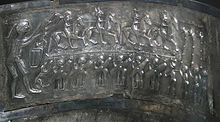Carnyx
The carnyx is a wind instrument of the Iron Age Celts , which dates from around 300 BC. Was in use until 200 AD. This is a horn-like curved bronze - trumpet , which was maintained during blowing. The mouth is usually shaped like a boar's head . The Carnyx was used in military campaigns (possibly also in cult activities), probably to incite the troops to battle and to demoralize the enemy with acoustic warfare .
Finds and evidence of the Carnyx
Representation on illustrations
The instrument is depicted on the Gundestrup kettle and on coins from the late La Tène period .
Evidence in the literature
The name has been passed down by several Roman authors. The use of a carnyx in the Celtic attack on Delphi in 279 B.C. Mentioned. Even Julius Caesar calls the Carnyx during his campaign in Gaul , as Claudius in the invasion of Britain .
Diodorus Siculus says in his Histories (5.30):
- Their trumpets were again of a peculiarly barbaric kind, they blow in and let out a harsh sound that is reminiscent of the turmoil of war
Even Polybius describes the fear of the Romans during the attack of the Celts in the Battle of Telamon .
Archaeological finds
A well-preserved specimen was found on the banks of the Moray Firth in Aberdeenshire , Scotland ( Deskford Carnyx ) in 1816 . By 2004, fragments of four other carnyces were found. In November 2004, archaeologists found five well-preserved instruments under a Gallo-Roman temple near Tintignac ( Corrèze department in France ). Four had the well-known wild boar head mouths, one ended in a snake head. An old find by Abentheuer in the Birkenfeld district in Rhineland-Palatinate had great equivalents to Tintignac. At Navan Fort ( County Armagh ) a Carnyx was discovered in a Seeopferplatz. It is known as the Loughnashade trumpet .
Carnyces in other cultures
The Carnyx was not only known to the Celts - it was also used in Dacia . Representations from the Dacian Wars can be found on the Trajan Column in Rome . Similar instruments were probably used by many of the peoples of Iron Age Europe. The Roman lituus were designed very similarly.
See also
- Lure , northern European wind instrument from the younger Bronze Age
- Shringa (Sanskrit), similarly shaped trumpet with an animal head from the same time in India
literature
- Helmut Birkhan : Celts. Images of their culture . Publishing house of the Austrian Academy of Sciences, Vienna 1999, ISBN 3-7001-2814-2 .
- Fraser Hunter: Reconstructing the Carnyx . In: E. Hickmann, I. Laufs, R. Eichmann (eds.): Studies on music archeology II. Music archeology in early metal ages. Lectures of the 1st symposium of the International Study Group on Music Archeology in the Michaelstein Monastery, 18. – 24. May 1998. In memoriam Hans Hickmann (1908–1968). VML Verlag Marie Leidorf , Rahden / Westfalen 2000, ISBN 3-89646-637-2 , pp. 341-345.
- Stuart Piggott: The Carnyx in Early Iron Age Britain . In: The Antiquaries Journal , Volume 39, 1959, pp. 19-32.
- John Purser: The Sounds of Ancient Scotland . In: E. Hickmann, I. Laufs, R. Eichmann (eds.): Studies on music archeology II. Music archeology in early metal ages. Lectures of the 1st symposium of the International Study Group on Music Archeology in the Michaelstein Monastery, 18. – 24. May 1998. In memoriam Hans Hickmann (1908–1968). VML Verlag Marie Leidorf , Rahden / Westfalen 2000, ISBN 3-89646-637-2 , pp. 325–331.
Web links
- Ancient Celtic music . Citizendium
- John Kenny: Carnyx and Co. carnyx.org.uk
- John Kenny: Demonstration of a reconstructed Carnyx in the British Museum (Engl.)
- Heike Zechner: When Troubadix blows the Karnyx ... ( Memento from October 10, 2008 in the Internet Archive ) archaeologischer.de, 2003
- Carnyx images on a gold stater by Caesar and on a silver denar , both from 48 BC. Chr.
Individual evidence
- ↑ AiD 2017/06 p. 5

